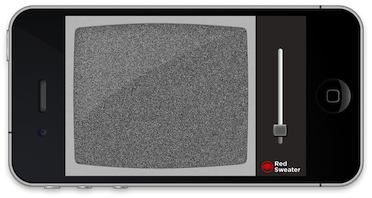January 20th, 2016
After a period of unavailability due to legal challenges, I am happy to announce that the app formerly known as “Shush” is available once again. It’s now called “Swish.” You can check it out on the iOS App Store.
Swish is a minimalist static noise generator, producing both static white noise (actually, pink noise) for your ears as well as visual white noise along the lines of what some of us remember from the television sets of our youths.

I came up with the idea for Swish in 2008, after my oldest son Henry was born. Static noise is soothing to many babies, and with the crying fits I was enduring, it seemed worth a shot. It did the trick for Henry, and has helped many other parents looking for an “always in my pocket” soothing source of static. Shush seemed the perfect name, because it embodies not only the verb meaning of trying to quiet somebody, but the sound of the static noise itself.
Because it was a whimsical side-project, I never expected to make a ton of money off Shush. And I haven’t. However, I maintained the app over the past 8 years, and released a major update when my second son, Matthew, was born. Needless to say, this project has been personally very meaningful to me.
A little over a year ago, I received a message from Apple that another developer had challenged my use of their trademark. Although I had been using the trademark myself for 7 years, they filed a trademark registration, and set to work demanding that I, and probably others, cease using the mark. I pushed back as long and as hard as I felt that I could without risking huge legal costs. I am confident that if I could justify the expense of defending the trademark, I would have prevailed because of my clear prior use of the mark. I could not, however, justify that cost. Hence the name change to Swish.
Swish is available for both iPhone and iPad. Before the trademark issue came to a head, I had built and submitted a version for Apple TV. It seemed like a perfect fit to me: I have witnessed fake static that ships with televisions, and is far inferior to the static I’m managed with some OpenGL tricks on iOS. I stripped the faux-television chrome from the UI and was left with an app that simply makes static when you launch it, and stops when you quit. Apple deemed the app too simplistic and suggested that I add more functionality. I continue to stew on that advice, but in the mean time, at least it runs on my television. I have the pleasure of occasionally turning my living room into an absurdly, amusingly vintage static noise environment, very reminiscent of my youth.
Posted in Apple, iPhone, Red Sweater News, Shush | Comments Off on Shush Is Now Swish
January 8th, 2016
I’m happy to share that the WordPress 4.4.1 release addresses the issue I reported previously with MarsEdit’s scheduled dates being misinterpreted by WordPress blogs.
Thanks to the WordPress team for taking the regression seriously and choosing to revert the change that was at the root of the problem.
Happy scheduling, everybody!
Posted in MarsEdit | Comments Off on WordPress 4.4.1: Scheduling Problem Solved
December 15th, 2015
WordPress 4.4 includes a change that affects the scheduling of posts, or changing of a previously published post’s “publish date.”
The change causes a discrepancy between the date as specified in MarsEdit, and the date as recorded on the blog server. Specifically: the time specified in MarsEdit will be adjusted by WordPress, by the hours offset from GMT that your blog’s timezone is set to. For example, if your blog server is configured for New York (Eastern Time in the U.S.), then a post set to publish at 11:00PM tonight will actually be published at 4:00AM tomorrow morning. You can find your blog’s time zone setting from the WordPress admin panel, under “General” settings.
When I went to investigate the problem on WordPress’s bug-tracking system, I found an existing report which covers the issue as it affects WordPress’s own Android app. Hopefully the significance of this issue will motivate the folks who introduced the change to reconsider their approach, and to restore proper functionality to clients including MarsEdit and others.
In the mean time, a workaround is to proactively adjust for your GMT offset when setting a post’s date in MarsEdit. If you want the post to go live at 11:00PM tonight, and your blog’s time zone is in New York: schedule the post for 6:00PM instead. After your post is published, you can confirm the actual scheduled time in the published posts list in MarsEdit, where the date column should show the expected 11:00PM.
Posted in MarsEdit, WordPress | Comments Off on WordPress 4.4 Scheduling Issue
December 10th, 2015
FastScripts 2.6.9 is now available from the FastScripts home page, and will be submitted to the Mac App Store for review by Apple.
This is a minor bug fix update to address a couple issues.
One has to do with subtleties around the way shell scripts are executed by FastScripts. Previously, FastScripts was inadvertently passing the contents of the script itself to the script’s standard input. It now takes care not to do this.
The other change is a minor fix to the Preferences UI in FastScripts, where the keyboard shortcuts for scripts are set. The disclosure hierarchy for navigating scripts should be preserved across launches of FastScripts. For the past few releases this has been broken, but now it’s working as expected again.
Complete list of changes:
- Fix to avoid copying contents of a script to the standard input when running a shell script
- Fix a bug that prevented the keyboard shortcuts script list in preferences from remembering its expanded state across launches
Enjoy!
Posted in FastScripts | Comments Off on FastScripts 2.6.9: Bug Fixes


